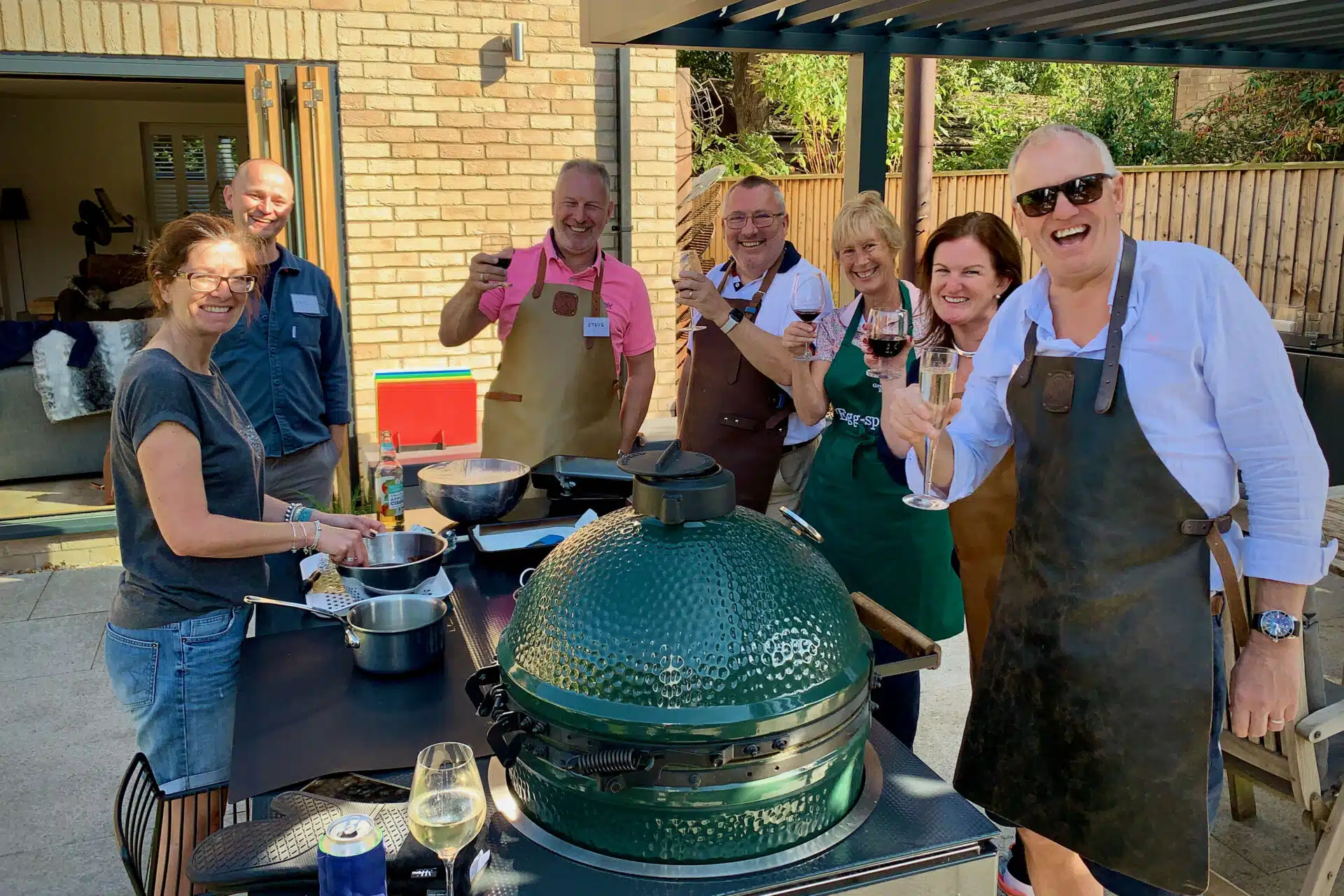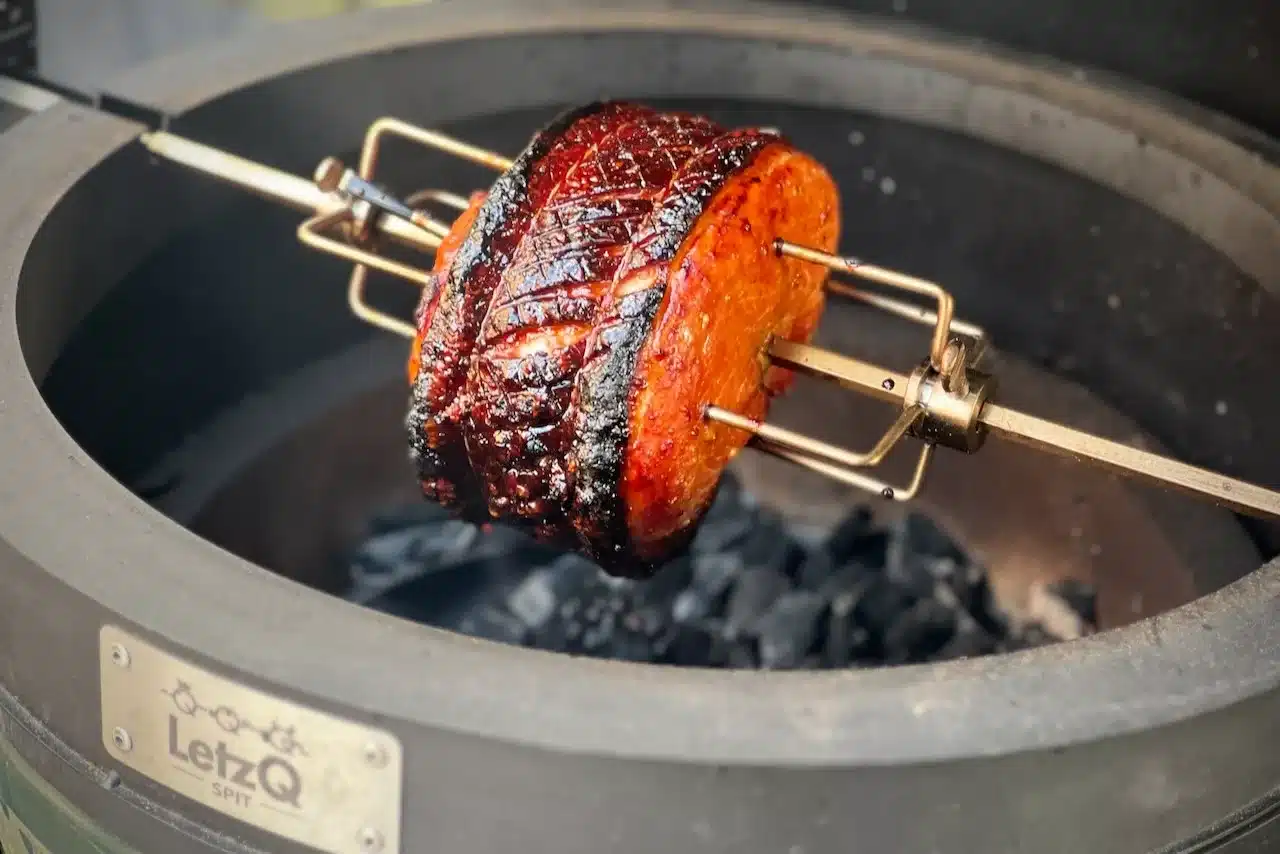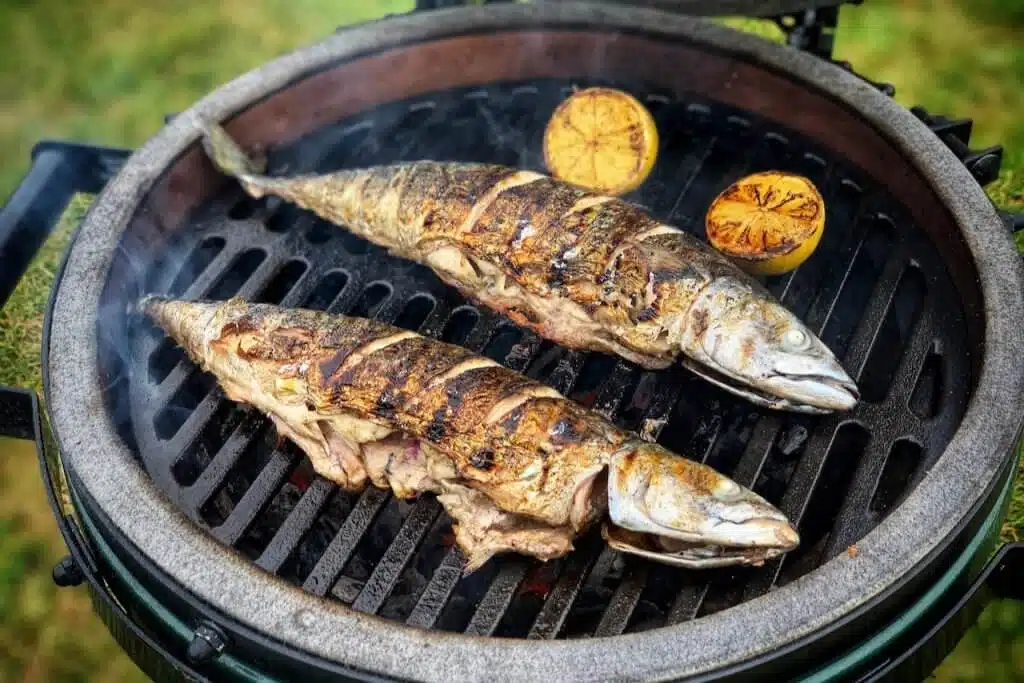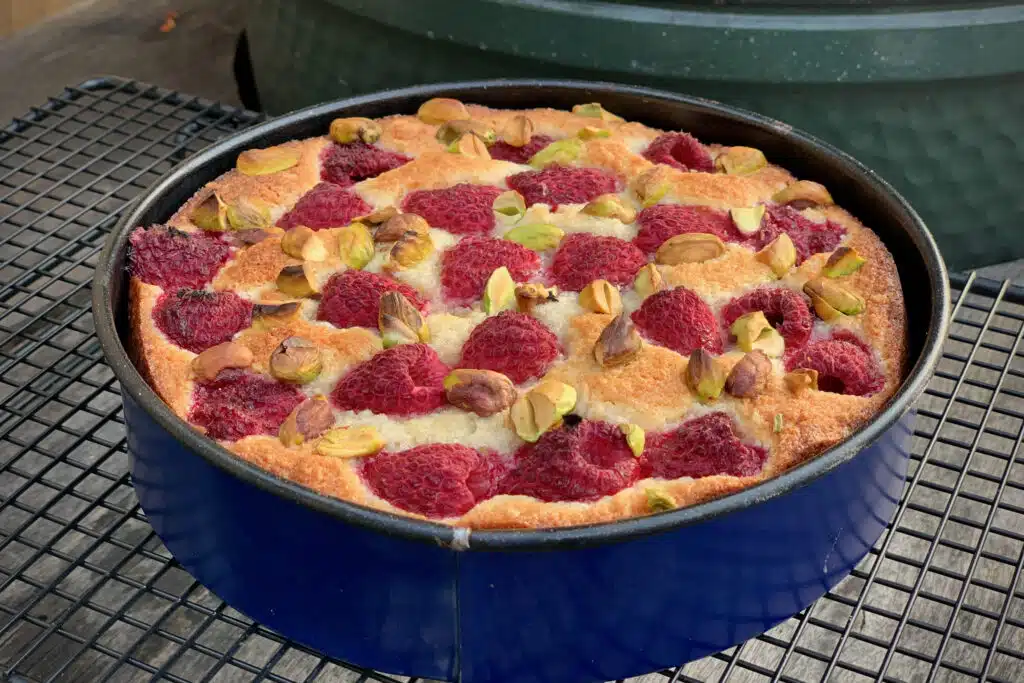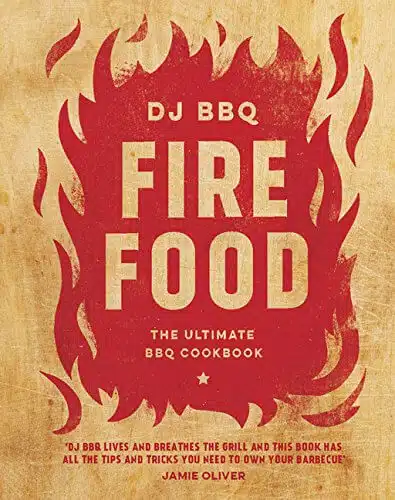



Reverse Seared Rib of Beef
The technique we used here was a reverse sear where we slowly raised the temperature of the whole piece of meat by cooking it at 110°C until its internal temperature was 50°C (5°C below medium rare). We then fired up the BBQ to about 250°C and seared the outside of the rib before resting it for about 15 minutes and serving in slices.
The initial cook was indirect, we used the plate setter feet up with the stainless grid on top. To that we added the meat and cooked slowly until the core temperature reached 50°C (5°C lower than the temperature we were aiming for as the last 5°C would be achieved when we seared the meat).
We then removed the plate setter and opened the air vents to raise the temp to 250°C. We used the cast iron grid to sear the rib for about 3 minutes on each side.

Dirty Steak vs. Seared Steak
The recipe is here for the dirty steak.
We fired up the MiniMax as well as your large to cook a steak traditionally on the large, using a cast iron grid, and dirty directly on the coals of the MiniMax.
Cooking the steak dirty adds a really meaty flavour to the steak. It’s also a little controversial when you have friends over. Very little ash sticks to the steak. I think it’s a great technique.
You can cook veg this way too. Daniel Clifford at Midsummer House in Cambridge cooks celariac and beetroot directly on the coal, it’s divine. DJ BBQ does an amazing dirtly carrot recipe in his book Fire Food.

Roast Cauliflower with Truffle Oil and Black Sesame Dressing
The technique here was to cook on the back side of the plate setter. All I did was wipe down the back of the plate setter with a dry paper towel or foil.
We set up the Egg to cook at 180-200°C with the plate setter feet down.
I cut the cauliflower into about 7mm thick slices all the way through the cauliflower. I removed most of the really thick bit of stalk before cooking. I then added a touch of oil and some maldon salt to the slices (on both sides) and placed them directly onto the plate setter. We then cooked them for about 5 minutes on each side until they start to turn golden brown.
To this we added the dressing. A great addition is to sprinkle toasted black sesame seeds to give a little crunch.

Lamb Rack, French Trimmed
This would be a great recipe to do with the cauliflower as it also can be cooked on the back of the plate setter (or a ceramic plancha).
Again we setup the Egg in an indirect configuration with the plate setter feet down. We set the temperature of the Egg to 180-200°C.
I scored the fat of the lamb rack in a diagonal pattern with the scoring about 3/4 cm apart. I then added a tiny bit of oil and generously seasoned the lamb with maldon salt.
I then cooked this directly on the plate setter, fat side down for about 15-18 minutes. At the last minute, we turned the lamb to add a little bit of sear to the edges.
I used a Themapen to probe the meat. For medium rare, we were looking for an internal temp of 58°C. The lamb will continue to cook while it’s resting so take it off about 3°C before (55°C for medium rare).
Always rest your meat wrapped in foil.

Focaccia
This Italian bread is really simple to make and an easy first go at baking on the Egg.
Make a batch of my basic bread recipe and let it rise. Knock it back and split into two portions. Push out each of these dough balls into the bottom of a 30cm x 20cm baking pan, lightly oil the top and cover with cling film. Put to one side to allow it to rise again.
When ready, poke it with your fingers to make the dimples. Drizzle generously with olive oil and sprinkle with salt and herbs (we used rosemary).
Setup your Egg for an indirect cook with the plate setter feet up, stainless steel grid on top and the baking/pizza stone on top of that. Get your Egg to 220°C and give the baking stone a while to heat up, probably 20 mins..
Cook your focaccia in the tin on the baking stone for about 15 minutes until it’s both golden brown on the top, but also crunchy on the bottom. Allow it to cool on a wire rack before serving.

Cedar Planked Sea Bass
The plank is designed to smoulder while the seabass roasts on top of it, taking on the wood flavour as it cooks.
Soak the planks in water for at least 1 hour before you use them. You can also soak them in other liquids such as:
- Beer, lager or cider.
- A dilution of citrus juice.
Get your Egg to 180°C in a direct setup with just the stainless or cast iron grids. Dry the side of the plank you will put the fish on, for about a minute, by placing it cooking side down on the Egg.
Take your seabass fillets and place them skin side down onto the plank. Use a set of tongs to move the plank onto the Egg. I put a slice of lemon onto the fish to show the smoke, not to add flavour. It looks pretty though.
Cook until the bass has firmed up enough to show it is cooked (about 8-10 mins). Take off the plank with tongs and put onto something heat proof.

Vertical Roast Chicken
This one always creates a laugh. The vertical roaster though is a great way of cooking the chicken, allowing air to circulate both around and within the chicken. This keeps it super moist.
If you want to make a gravy then use a drip pan under the vertical chicken roaster. You can also fill this pan with root veg to cook at the same time, doing your whole Sunday roast in one go.

Apple Tarte Tatin
The recipe is here, just substitute apples for the peaches.
This was our last cook of the day, sadly I caught the caramel as we were serving the roast chicken.
We used one of the Tefal pans to make a caramel before addding the peaches, butter and pastry. The caramel was cooked direct on the MiniMax, we then baked it (indirect) on the Large Egg. You could always do the first stage on the hob inside.
Don’t stir the caramel, it’ll crystallise. Just leave it until the colour starts changing.
Be careful with the flip at the end, hot caramel burns. Make sure you’re not under pressure with a big audience :-).
Technique
What temperature should I cook at?

Cooking temp guide from AmazingRibs.com
What are the best cuts of steak?
The process of ageing meat allows the naturally present enzymes to break down the muscle, making it more tender. Most supermarkets only age their meat for 21 days, a good butcher will go 28 days or beyond, sometimes over 100 days. During this process the meat will dry out and shrink, loosing weight, so a dry aged steak will probably cost more per kilo as the butcher has had to store it and it’s also lost water content meaning the same piece of meat is now lighter.
Ageing will take place on whole joints before they are cut into steaks. Individual steaks shouldn’t be aged.
Having said all that here are my takes on different cuts:
- Rump steak – probably one of the most flavoursome cuts but because this muscle works harder than most of the others here, it can be a little tougher. My local butcher though will tell you it’s one of his favourite cuts because of the taste.
- Picanha – this is the rump cap. Cooked as we did it during the lesson, a reverse sear, this is my favourite joint.
- Sirloin – slightly more tender than rump but with slightly less flavour. Not too fatty. I normally avoid these.
- Rib-Eye – the next step up from Sirloin but with a great fat content. Think of fat as flavour. Even if you don’t eat it you can render it in a hot pan or vaporise it by cooking dirty. This will add flavour back to your steak. This is my go to steak when not cooking a Picanha.
- Fillet – Super tender as this muscle does next to nothing. However there isn’t much fat so there isn’t much flavour. If texture is your number 1 then this is the steak for you.
- T-Bone – this is bone with the fillet on one side and the sirloin on the other. It looks great.
- Cote de Boeuf – a bone in rib of beef, it’s just stunning but very expensive. It’s the ultimate steak if money is no object.
- Forerib of beef – this is normally a 3 or 4 bone rib joint. Do it as a Sunday roast or for Christmas. My favourite way of doing it is the reverse sear it. A 4 bone rib will cost about £130-£150.
- Beef short ribs or Jacobs Ladder – these are from the tougher part of the animal and need to be slow roasted for 8 or 9 hours. People rave about them but I can take or leave them, I’d much prefer most of the cuts above.
The Stall or Plateau explained
The best resource on this is at AmazingRibs.com. Give it and the other articles a read. It’s a superb site.
What settings are needed for specific temperatures?
Rest your meat
There is a great article discussing whether this is a myth but I still like to rest my meat: http://amazingribs.com/tips_and_technique/mythbusting_resting_meat.html
Reverse Sear
Using Planks Multiple Times
- Lemon and lime – lovely citrus flavours go well with fish
- Beer, cider or lager
Now instead of using the planks directly over the charcoal, use your ConvEGGtor (plate setter) feet up with the stainless steel grid and place the planks onto the stainless grid. You’ll still get the wood flavouring but it won’t burn your planks away.
Remember always place your planks onto a heat resistant surface when you take them off the Egg.
Using a cool box to rest meat
Once your meat is cooked, wrap it in several layers of aluminium foil and place it into your cool box. Cover then with bath towels and then shut the lid. Make sure you use old towels as you’ll never get the smell of BBQ out of them!
Cleaning your Egg
Clean the ash from your Egg every five or so cooks. Use the ashtool to do this.
Every 12-15 cooks take the whole of the inside of your Egg out and brush down with the dustpan and brush. Some people hoover out their Eggs but if you do this make sure it is cold, I had a customer set her Henry on fire.
Lighting your Egg
There is a great set of videos called the Tips Series that Big Green Egg UK put together.
Rust on your Egg cast iron cap and searing grid
You’ll need to repeat this process a couple of times a year.
Equipment
Wireless Thermometers
Thermoworks who make the Thermapen, have launched the Thermoworks Smoke in the UK finally. This is the best wireless thermometer in my opinion, it’s so easy to use and has super accurate probes. It’s not a replacment for a handheld probe thermometer like the Thermapen you already have but it does allow you to monitor cooks from the comfort of an armchair.
This was the device I used for the reverse seared beef rib.
Pans with handles that clip on and off
They’re a product from Tefal that I picked up several years ago in France before I got into the Big Green Egg as they were perfect for the camper van. They’re called Tefal Ingenio and are available in the UK now from Amazon.
The handle clips on and off easily so you pop the pan in the Egg and take the handle off. I use mine all the time. They’re great for cooking tarte tatin.
Just be careful with non stick ones that you don’t get them too hot as the non-stick will start to break down.

Recommended Cook Books
Fire Food
Just launched by DJ BBQ (Christian Stevenson). DJ BBQ does a lot of cooking with Jamie Oliver. There are some fabulous and easy recipes in here.
There is a whole section on dirty cooking (cooking directly on the charcaol). I have done the dirty carrots and can highly recommend them. The book was only release last week.
Meathead
This is by Meathead Goldwyn, the man behind the AmazingRibs.com website. It’s got some really good stuff on technique as a well as some good recipes. It’s available on Amazon from this link.
Food DIY
Tim Hayward is a Cambridge based food writer, restauranteur and chef. He’s judged on the BBQ scene. His book contain loads of great curing recipes as well as BBQ stuff. I really love it and use the recipes all the time. It’s available on Amazon from this link.
